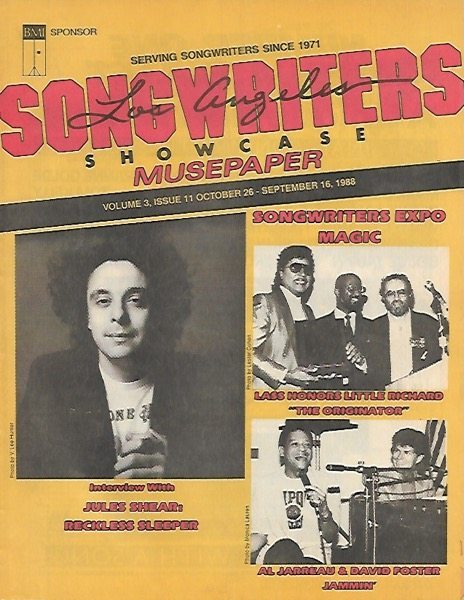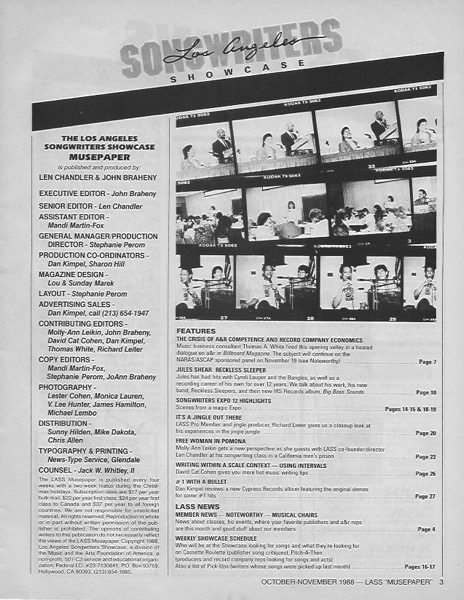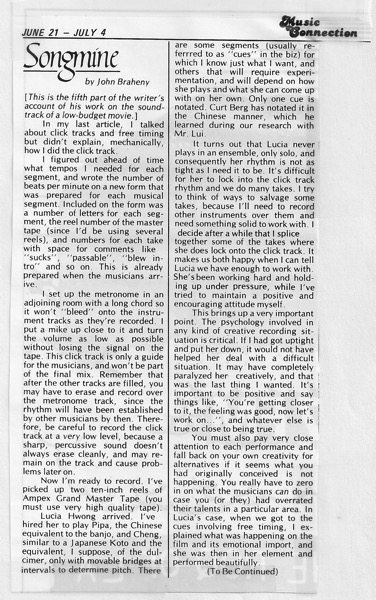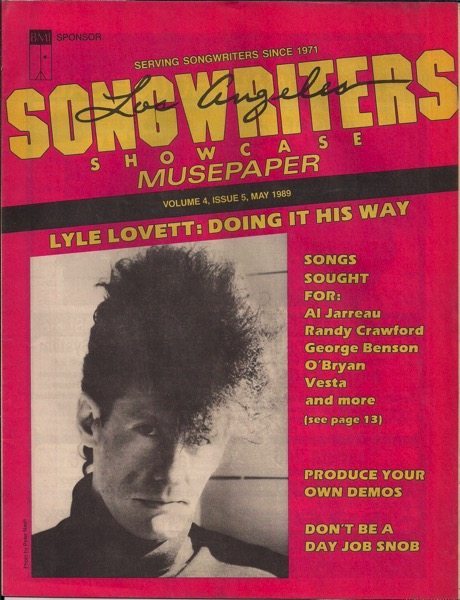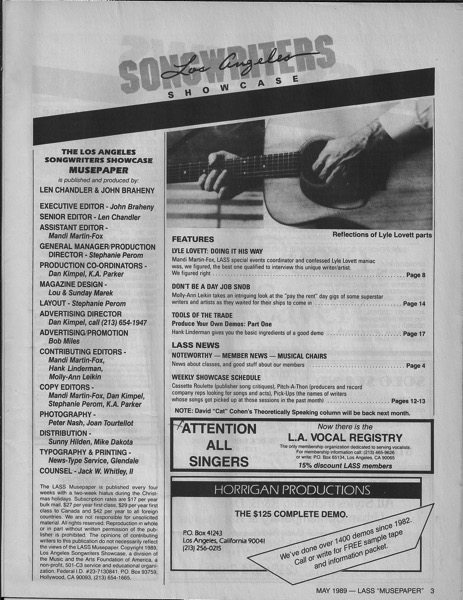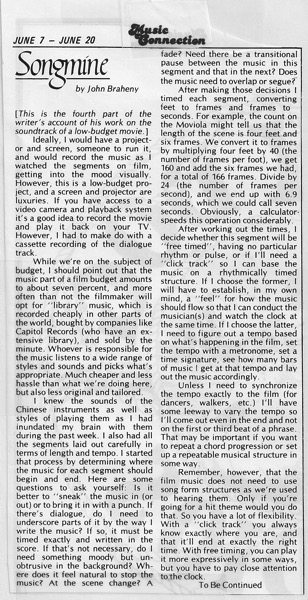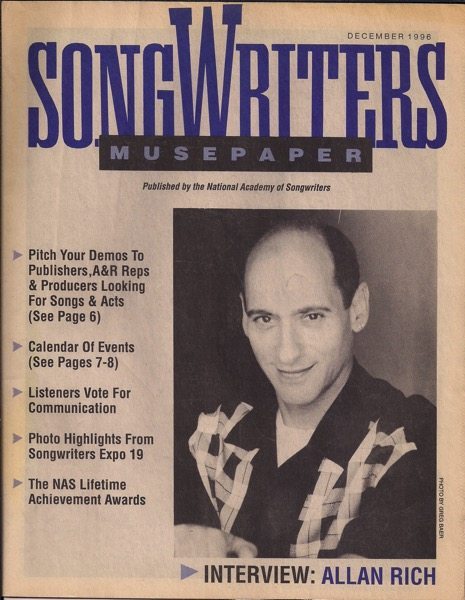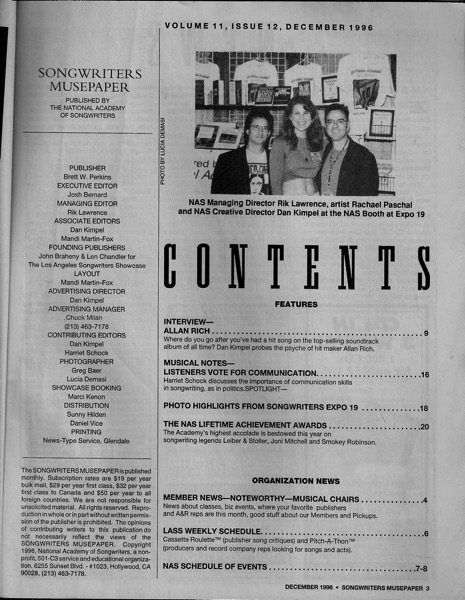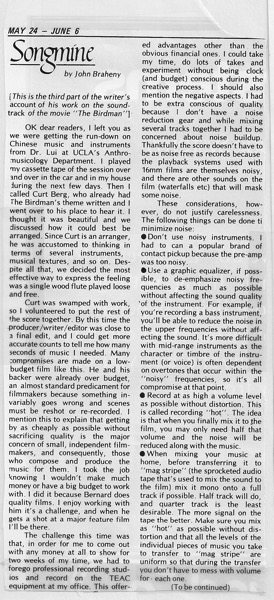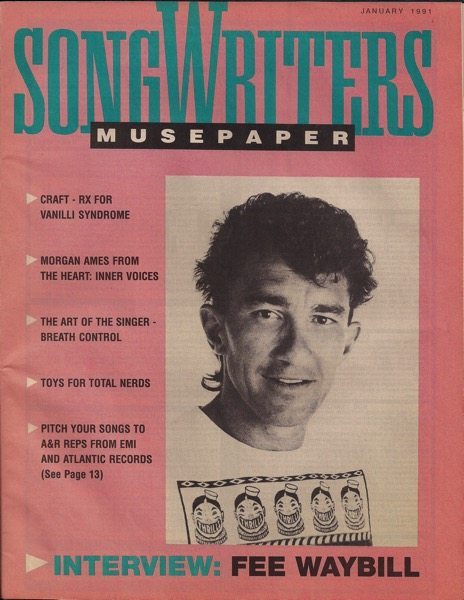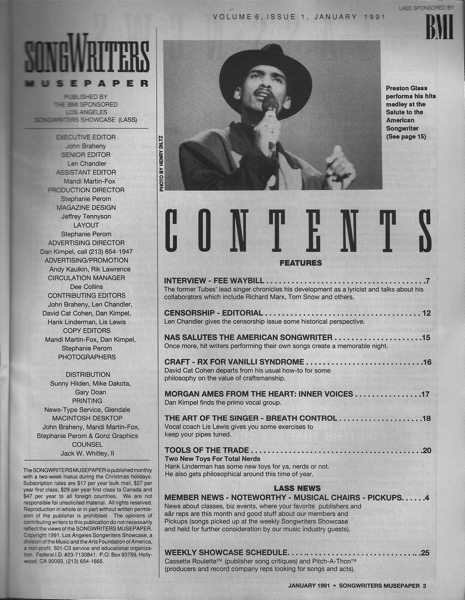A John Braheny Songmine column from the archives…
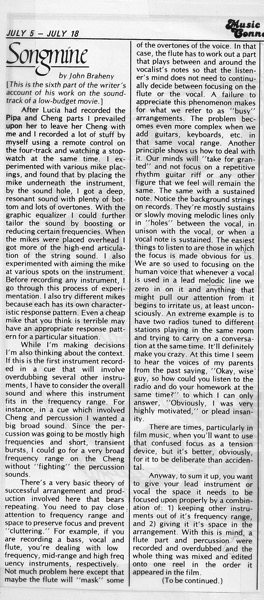
Accession Number: C000000137-020-002 Document/Digital File, “Songmine: Scoring Films on a Low Budget Part 6 by John Braheny”, OCR converted text under same Accession Number
(Digitally converted text. Some errors may occur)
JULY 5 — JULY 18
Songmine by John Braheny
[This is the sixth part of the writer’s account of his work on the sound-track of a low-budget movie.]
After Lucia had recorded the Pipa and Cheng parts I prevailed upon her to leave her Cheng with me and I recorded a lot of stuff by myself using a remote control on the four-track and watching a stop-watch at the same time. I ex-perimented with various mike plac-ings, and found that by placing the mike underneath the instrument, by the sound hole, I got a deep, resonant sound with plenty of bot-tom and lots of overtones. With the graphic equalizer I could further tailor the sound by boosting or reducing certain frequencies. When the mikes were placed overhead I got more of the high-end articula-tion of the string sound. I also experimented with aiming the mike at various spots on the instrument. Before recording any instrument, I go through this process of experi-mentation. I also try different mikes because each has its own character-istic response pattern. Even a cheap mike that you think is terrible may have an appropriate response patt-ern for a particular situation.
While I’m making decisions I’m also thinking about the context. If this is the first instrument record-ed in a cue that will involve overdubbing several other instru-ments, I have to consider the overall sound and where this instrument fits in the frequency range. For instance, in a cue which involved Cheng and percussion I wanted a big broad sound. Since the per-cussion was going to be mostly high frequencies and short, transient bursts, I could go for a very broad frequency range on the Cheng without “fighting” the percussion sounds.
There’s a very basic theory of successful arrangement and prod-uction involved here that bears repeating. You need to pay close attention to frequency range and space to preserve focus and prevent “cluttering.” For example, if you are recording a bass, vocal and flute, you’re dealing with low frequency, mid-range and high frequency instruments, respectively. Not much problem here except that maybe the flute will “mask” some of the overtones of the voice. In that case, the flute has to work out a part that plays between and around the vocalist’s notes so that the listen-er’s mind does not need to continu-ally decide between focusing on the flute or the vocal. A failure to appreciate this phenomenon makes for what we refer to as “busy” arrangements. The problem bec-omes even more complex when we add guitars, keyboards, etc. in that same vocal range. Another principle shows us how to deal with it. Our minds will “take for gran-ted” and not focus on a repetitive rhythm guitar riff or any other figure that we feel will remain the same. The same with a sustained note. Notice the background strings on records. They’re mostly sustains or slowly moving melodic lines only in “holes” between the vocal, in unison with the vocal, or when a vocal note is sustained. The easiest things to listen to are those in which the focus is made obvious for us. We are so used to focusing on the human voice that whenever a vocal is used in a lead melodic line we zero in on it and anything that might pull our attention from it begins to irritate us, at least uncon-sciously. An extreme example is to have two radios tuned to different stations playing in the same room and trying to carry on a conversa-tion at the same time. It’ll definitely make you crazy. At this time I seem to hear the voices of my parents from the past saying, “Okay, wise’ guy, so how could you listen to the radio and do your homework at the same time?” to which I can only answer, “Obviously, I was very highly motivated,” or plead insan-ity.
There are times, particularly in film music, when you’ll want to use that confused focus as a tension device, but it’s better, obviously, for it to be deliberate than accidental.
Anyway, to sum it up, you want to give your lead instrument or vocal the space it needs to be focused upon properly by a combin-ation of: 1) keeping other instru-ments out of it’s frequency range, and 2) giving it it’s space in the arrangement. With this is mind, a flute part and percussion_ were recorded and overdubbed and the whole thing was mixed and edited onto one reel in the order it appeared in the film.
(To be continued.)
Previously in the Songmine Collection:
- Scoring Films on a Low Budget Part 5 by John Braheny
- Songmine: Scoring Films on a Low Budget Part 4 by John Braheny
- Songmine: Scoring Films on a Low Budget Part 3 by John Braheny
- Songmine: Scoring Films on a Low Budget Part 2: Research and Spotting
- Songmine: Scoring Films on a Low Budget Part 1
- Songmine: The Chances for Advances by John Braheny
- Songmine: What a Record Company Needs to Know – Part 6: Attorneys by John Braheny
- Songmine: What a Record Company Needs to Know – Part 5: The Professional Team by John Braheny
- Songmine: What a Record Company Needs to Know – Part 4: What Makes This Act Marketable? by John Braheny
- Songmine: What A Record Company Needs to Know : Part 3
- Songmine: What A Record Company Needs to Know: Part 2 by John Braheny
- Songmine: What A Record Company Needs to Know: Part 1 by John Braheny
- Songmine: Getting the Most from the Trades Part 4
- Songmine: Getting the Most from the Trades Part 3 by John Braheny
- Getting the Most from the Trades
- Songmine: Publishing III
- Songmine: Leave Your Ego at the Door
- Songmine: “Feedback: Why some publishers won’t give it”
- Songmine: Dealing with Rejection by John Braheny
- “Music in Print” – A Songmine Column from Music Connection Magazine March 19-April 1, 1981
About Songmine and Music Connection Magazine:
John Braheny met Eric Bettelli and Michael Dolan right before they were going to publish Music Connection magazine. Eric and Michael wanted to get their publication out to as many songwriters as they could. They had already heard of the LA Songwriters Showcase, and of John and his partner, Len Chandler. John’s goal was to advertise the schedule of guest speakers and performers at the weekly Showcase… so they made a deal.
They published John’s Songmine column (he had never before written a magazine article!) in their very first edition, in November 1977. Trading out the column for advertising, this arrangement continued for many years. Plus, Eric and Michael came to the Showcase each week and distributed free copies to the songwriters!
Those articles became so popular that (book agent and editor) Ronny Schiff offered John’s articles to F&W Media, where they became the backbone of John’s textbook, The Craft and Business of Songwriting. As a follow-up, Dan Kimpel (author, songwriter, teacher), who had also worked at LASS, took on the Songwriting column at Music Connection magazine which continues to this day! You can subscribe to get either hard copies or online.
